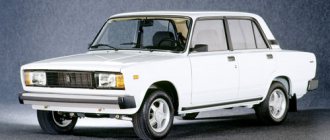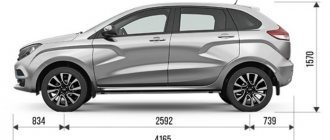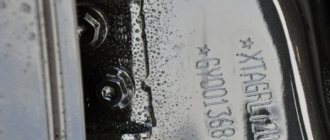Vesta Sport’s signature “typhoon” color looks gorgeous. It has a metallic effect, but you can only see it closely. The front track, widened by 18 mm, is covered by plastic fenders - an original body part of Vesta Sport. The first version of the press release talked about reducing the ground clearance from 178 to 162 mm (- 16 mm), in the next edition - to 147 mm (- 31 mm). I went to check it myself and measured 155 mm (-23 mm) under the crankcase protection. Still not bad, but you're starting to be cautious. The front bumper is lowered even more: on a regular Vesta it is separated from the asphalt by 270 mm, on a “sports” one - only 185 mm. For the first time on a Lada: following the rotation of the steering wheel, the corresponding fog lamp - left or right - lights up, illuminating the turn. The idea is good, but it had to be implemented with different optics. Vesta's fog lights are not able to provide additional lighting.
Vesta Sport’s signature “typhoon” color looks gorgeous. It has a metallic effect, but you can only see it closely. The front track, widened by 18 mm, is covered by plastic fenders - an original body part of Vesta Sport. The first version of the press release talked about reducing the ground clearance from 178 to 162 mm (- 16 mm), in the next edition - to 147 mm (- 31 mm). I went to check it myself and measured 155 mm (-23 mm) under the crankcase protection. Still not bad, but you're starting to be cautious. The front bumper is lowered even more: on a regular Vesta it is separated from the asphalt by 270 mm, on a “sports” one - only 185 mm. For the first time on a Lada: following the rotation of the steering wheel, the corresponding fog lamp - left or right - lights up, illuminating the turn. The idea is good, but it had to be implemented with different optics. Vesta's fog lights are not able to provide additional lighting.
| LADA VESTA 1.8 MT | LADA VESTA Sport | |
| Dimensions and weight | ||
| Length Width Height | 4410 / 1764 / 1497 mm | 4420 / 1774 / 1478 mm |
| Wheelbase | 2635 mm | 2635 mm |
| Front/rear track | 1510 / 1510 mm | 1528 / 1514 mm |
| Ground clearance under crankcase protection* | 175 mm | 155 mm |
| Ground clearance under the front bumper* | 270 mm | 185 mm |
| Curb weight | 1380 kg | 1322 kg |
| Engine | ||
| Working volume | 1774 cm3 | 1774 cm3 |
| Power | 90 kW/122 hp at 5900 rpm | 106.6 kW/145 hp at 6000 rpm |
| Torque | 170 Nm at 3700 rpm | 182 Nm at 3600 rpm |
| Transmission | ||
| Type, model | M5, JR5 | M5, JR5 |
| Chassis | ||
| Wheels | 15″, 16″ | 17″ |
| Tires | 185/65 R15, 195/55 R16 (Matador, Pirelli) | 205/55 R17 (Continental) |
| Front strut rod diameter | 20 mm | 22 mm |
| Front strut working cylinder inner diameter | 30 mm | 32 mm |
| Front pillar housing outer diameter | 48 mm | 52 mm |
| Rear shock absorber rod diameter | 12.4 mm | 14 mm |
| Rear shock absorber working cylinder inner diameter | 27 mm | 30 mm |
| Rear shock absorber housing outer diameter | 40.9 mm | 45 mm |
| Aerodynamics | ||
| Front axle lift | 33.0 kg | 7.8 kg |
| Rear axle lift | 22.2 kg | 11.6 kg |
| Dynamics and fuel consumption | ||
| Fuel | AI-92, AI-95 | AI-95 |
| Maximum speed | 186 km/h | 193 km/h |
| Acceleration 0–100 km/h | 10.2 s | 9.6 s |
| Fuel consumption: urban/suburban/combined cycle | 9.5 / 6.2 / 7.4 l / 100 km | 10.6 / 6.4 / 7.9 l / 100 km |
*ZR measurements.
Buyers from the budget segment, oh, how they want to stand out from the ocean of their own kind! So the Sport, GT, Extreme, etc. nameplates appear on cars. As a rule, factory tuning does not affect driving performance in any way. There is no deception: the consumer wants - the consumer gets. The Lada Vesta Sport with a 145-horsepower engine is a different story, with more than two hundred modernized or new parts compared to the original Vesta 1.8 MT sedan.
Form
It's hard to imagine what Lada would be like without Steve Mattin. He was a success in all the VAZ projects he took on, and Vesta Sport is no exception. They didn’t spoil the standard car with a shocking body kit; they put on a catchy make-up, but without vulgarity, except that they went too far with the rear bumper: the side false diffusers on it are superfluous.
I wrote the previous paragraph and I can just hear comments about “show-offs for beggars.” Let me note that AVTOVAZ is not a pioneer here. AMG packages for basic versions of Mercedes, M body kits for low-power BMWs and the S line option for “vegetable” Audis are not the worst examples to follow.
For Lada Cross the corporate color is orange, and for Vesta Sport it is red. There are a lot of bright accents in the cabin, but without going overboard. Special thanks for the leather trim on the steering wheel and gear lever. The French mechanics JR5 is the only important unit that has not been modernized. They moved from a 122-horsepower car without changing the gear ratios and clutch. There are no complaints about the switching accuracy. The plastic decor in the cabin is carbon fiber and piano lacquer. The brightness of the red inserts on the control panel is optimal: it does not burn your eyes at night and does not impair the readability of the readings. | |
A cool design find - a black ceiling. And by the way, it's not that cheap. Along with the trim, we had to order all the interior fittings above the lower edge of the windows in a new color. |
Metal pedal covers are also included in the required set. In red lighting they look infernal. |
Everything inside is familiar, but no longer average. Alcantara and carbon fiber inserts are the law of the genre. In the end, budget status does not oblige everyone to vegetate surrounded by dull gray fabric and black plastic. And there is no need to blame Vesta for unnatural materials: at its price, this is in the order of things.
New Lada Vesta Sport 2022: photo and price, sedan characteristics
The long-awaited car for many fans of the domestic automobile industry has finally entered the market. We are talking about a charged sedan from AvtoVAZ - Lada Vesta Sport 2022. The new model differs from the basic version of the car in a more aggressive design, which uses a lot of decor, an improved interior with the latest developments of the brand, as well as top-end, by the standards of the Russian automobile industry, characteristics.
Unfortunately, the restyling and improvement of Vesta led to its high cost - the price of the car will start at almost a million rubles.
Navigation
Pros and cons of Lada Vesta Sport
+ Pros
- Comfort
- Controllability
- Design
- Noise insulation
- Patency
- Safety
- Dynamics
- Reliability
- Minuses
- Build quality
- Fuel consumption
- Cabin capacity
- Suspension
Reviews from Lada Vesta Sport owners
I would like 6th gear, because on the highway this is a necessary thing. In the city, 5 mortars are enough. Already the aforementioned squeaking noise when braking. I understand that even owners of cars of a higher class and in a completely different price segment face a similar problem, but damn it, AvtoVAZ =). For some reason, there is no heated rear seats, although in other Lada models it can be seen as an option. That's probably all for now.
Well, I became the owner of the long-awaited Lada Vesta Sport. Briefly about the car, steering and brakes are just fire! I’m not putting any pressure on the engine yet, as it’s just being run-in) But it feels like there’s traction from the bottom! In general, the car is fire and I don’t regret the fact that I paid more than a cartoon for it! Currently the mileage is 1,600 km)
It is at least no worse than foreign cars in a similar price segment. The suspension “swallows” road irregularities, but remains moderately stiff and comfortable. Turns - with a bang! In fact, it is very good in turns, and the lateral supports of the seats tenaciously hold the driver and do not allow him to lose control of the road.
The engine in the Vesta Sport is enough for me both for the city and for the highway! The brakes are good, they cope with adequate speed, I haven’t tried to brake to the floor from 150, I hope it won’t come to that, I’m not a racer, I mostly ride with my family. The clearance allows you to drive along curbs)) They say the box is howling, well, I don’t know, I don’t hear anything, everything works in normal mode, no louder than at the same fluence, or maybe I just didn’t listen to that extent. The suspension can be somewhat noisy, but it is energy-intensive.
Reviews from Lada Vesta Sport car owners with photos on drive2.ru, avtovaz.ru, ironhorse.ru and auto.ru
Lada Vesta Sport 2022 prices and specifications
The price of Lada Vesta Sport 2022 in Russia ranges from 1,256,900 to 1,312,900 rubles, the sedan is offered in the Luxe configuration.
| Equipment | price, rub. |
| 1.8 (145 hp) Luxe MT5 | 1 256 900 |
| 1.8 (145 hp) Luxe EnjoyPro MT5 | 1 312 900 |
* MT5 - five-speed manual transmission
Technical characteristics of Lada Vesta Sport
Body
| Body type | sedan |
| Car class | class B |
| Length / width / height, mm | 4420 / 1774 / 1478 |
| Wheelbase, mm | 2635 |
| Ground clearance (ground clearance), mm | 147 |
| Trunk volume, l | 480 |
| Curb weight, kg | 1322 |
| Fuel tank volume, l | 55 |
Engine and transmission
| engine's type | petrol |
| Volume, l | 1,8 |
| Power, hp | 145 |
| Torque, Nm | 184 |
| Gearbox type | Mechanics |
| Number of gears | 5 |
| Drive unit | front |
| Acceleration 0-100 km/h, s | 9,6 |
| Max speed, km/h | 193 |
| Fuel consumption, l | |
| - city | 10,6 |
| - track | 6,4 |
| - mixed | 7,9 |
| Fuel type | AI-95 |
Behind the wheel
The new Lada Vesta Sport is equipped with a 1.8-liter engine, boosted from 122 to 145 hp. and from 170 to 187 Nm. The engine is mated to a Renault five-speed manual transmission with cable shift mechanism. The drive shafts have been strengthened, the number of splines has increased from 24 to 29. The engine also has new camshafts with a modified profile (the cam lift has been increased), plus the pressure in the fuel system has been increased, and the valve timing adjustment system has been reconfigured. A test drive of the car showed that under ideal conditions, it accelerates to 60 mph in 9.6 seconds, and the top speed is limited to 200 km per hour.
Video test drive of the new Lada Vesta Sport
Read test drives of Lada Vesta Sport on Autoreview, Drive.ru, Kolesa.ru, Behind the Wheel
Appearance
Of course, the design of the new Lada Vesta Sport 2022 is the strongest point of the car. The new body differs from the regular Vesta with very aggressive body kits, a lot of relief, wheels and optics.
The front part of the car differs least from the starting version of the sedan. She is still the same short and low, but a decent amount of aggression comes from her. This is facilitated by the new hood, which has a large recess in the center and slightly protruding side parts. As before, the radiator grille here takes the shape of the letter “X”. On top of it you can find the largest cutout, which provides air access to the engine compartment. This cutout ends on both sides with aggressive headlights, positioned at an angle and filled with halogens or xenon.
As for the body kit, there are also plenty of interesting elements. In the center there is another huge cutout that improves the cooling of the engine compartment. Also, the side parts were not left without bars. In the extended configuration, they also include built-in fog signals. Naturally, the body is decorated to the maximum with all sorts of relief.
The most formidable part here is the rear of the car. The short but tall trunk boasts a slightly angled lid, equipped with a spoiler lip for better aerodynamics. Next are slightly inclined rectangular headlights, as well as the embossed main part of the door. What attracts the most attention is the body kit, which takes up almost a third of the entire bumper area. Here you can find massive air intakes located on the sides, a diffuser with another false mesh and a metal insert with two huge exhaust pipes located at different edges.
Salon
Autoreview
In the interior design of the Lada Vesta Sport 2022, one of the key elements is the “red ribbon” running along the perimeter of the body. Red accents, designed to emphasize the sporty character of the new version, are also present in the interior. Red Alcantara inserts with X-graphics are made on the front seats, the main upholstery of which is eco-leather with a “carbon” texture and red stitching. In addition, the inscription “Vesta Sport” is embroidered on the backs of the seats below the headrests. This is not visible in the photo, but... The steering wheel, manual gearbox and parking brake handle are also trimmed in black eco-leather.
The instrument panel of the new product has an exclusive design and backlighting in red, the air ducts received a black glossy coating, which is repeated on the door handles, while the door and front panels have carbon-look decorative inserts. The ceiling and pillars of the car are upholstered in black material.
In the center of the dashboard there is always a huge multimedia system monitor, from which almost all the functionality of the car is configured. Next to it you can see neat air ducts framed with black glossy elements. A little lower is a modest console, which includes climate control washers.
The tunnel, unfortunately, is not luxurious. It turned out to be very thin and short. The designers managed to place here such elements as cup holders, an undisguised organizer for things, a gearbox control knob, buttons for activating heated seats and an armrest, which, like in the previous Vesta, is equipped with a regular or cooled glove compartment.
All seats in the car have undergone significant modifications. All of them will be finished with higher quality fabrics and even artificial leather. Also, the front seats now have pronounced lateral support and excellent headrests, the tilt of which can be adjusted to suit you. The seats located in the front also boast a heating system, installed in any configuration, and electrical position adjustments in several directions. The back row has become more spacious and comfortable. Here you can also find heating, but in an expanded version, an armrest with holes for glasses and an adjustable backrest.
Photos of the new Lada Vesta Sport 2021
PreviousReviewsNew Lada Vesta SW 2022: photo and price, station wagon specifications
Next
ReviewsNew KIA Xceed 2022: photo and price, characteristics of a crossover based on a hatchback
In queue!
Considering the similarity of the sedan and station wagon below the belt line, I couldn’t help but ask the VAZ team a question: will there be a Vesta SW Sport? The answer depends on the demand for the sedan. The transformation will cost more than in the case of cross-versions: the five-door will have to carefully work out the aerodynamics. The rear disc brakes are borrowed from the Vesta SW Cross (the front ones are original, ventilated, with a diameter of 300 mm). The brake pads all around are domestic, TIIR brand.
Considering the similarity of the sedan and station wagon below the belt line, I couldn’t help but ask the VAZ team a question: will there be a Vesta SW Sport? The answer depends on the demand for the sedan. The transformation will cost more than in the case of cross-versions: the five-door will have to carefully work out the aerodynamics. The rear disc brakes are borrowed from the Vesta SW Cross (the front ones are original, ventilated, with a diameter of 300 mm). The brake pads all around are domestic, TIIR brand.
Perhaps the main question is how much? VAZ has not yet announced the price of the Sport version. I managed to find out the starting point: a car in a basic, well-packaged configuration will cost just under 900 thousand rubles. A single package of options with navigation, a rear view camera and a heated windshield will raise the price, presumably by thirty to thirty-five thousand.
Lada Vesta Sport: to buy or not? Verdicts of Autoreview journalists and guest authors
Vesta Sport boosted to 145 hp A VAZ 1.8 engine in the Luxe configuration costs 1 million 10 thousand rubles: climate control, combined seat upholstery, rear parking sensors, cruise control, light and rain sensors. And we received a metallic painted (plus 12 thousand) top version of Luxe Multimedia, complemented by an electrically heated windshield, a rear view camera and a media system with a navigator - for 1 million 58 thousand. But in any of the trim levels there are only two airbags.
As Ferdinand Porsche said, if you can’t find the VAZ of your dreams, build it yourself. As far as I understand, the sports Vesta is made exactly according to this principle. I’ll tell you even more: the guys from the Lada Sport division not only created the VAZ of their dreams, they also nobly gave anyone the chance to feel like Ferdinand.
Still, I can hardly imagine a situation in which Vesta for a million is the ultimate dream. The “charged” Lada must be cheap and merciless, otherwise what’s the point? And Vesta is not very good at either. Yes, it drives excitingly, but you won’t even be able to tell any of your friends about it, because to do this you first need to catch up with someone. For a Russian national sports car, Vesta has a too intelligent philosophy: it is designed for corners, interesting roads and a complex surface profile. I don’t remember that anyone else in this class and in this price range could grip the asphalt so tenaciously and handle bumps so easily. And fortunately, our “fitting room” included a specimen that loves to wag its tail when releasing the gas. This Lada is a great car for the swollen and twisted "B-Roads", minor tracks somewhere in Middle England. But in Russia, Vesta urgently needs to pump up her muscles. The bucket must have fists.
Therefore, I propose to consider Vesta Sport not as a finished product, but as a project. Korch. Then the price is no longer a price, but a budget. For a million you immediately have a body, cool seats, brakes, wheels, cosmetics, additional engine support and most importantly - suspension. I remember well how fifteen years ago I bothered with installing springs, adjustable shock absorbers and “stubs” on a VAZ-2112. A stretcher under the hood, a littered caster... Everything so that the Lada drives “like a foreign car.” And it went, of course, but for some reason the suspension only lived from breakdown to breakdown.
At that time I could only dream about the kit that Vesta Sport already has. All that remains is to add water - that is, the motor. Power. Accelerator response. Release. And a normal “mechanics” drive. Do you understand how much scope there is for Ferdinandism? Oh yes, there is a bit of Porsche in this Lada! And this is even more important than the ability to overtake Solaris.
The full version is available only to subscribersSubscribe now
I'm already subscribed
The dynamics are not amazing, but the main thing about it is the suspension.
Lada Vesta Sport: what is really sporty about it- The SOTRA 3D organizer will look stylish in the trunk of Vesta Sport. And don’t forget about the “Ш” sign: no one has canceled it yet!
Photo: AVTOVAZ
avtoexperts.ru
AvtoVAZ has extensive experience in creating pseudo-sports cars. “Nine”, “Ten”, “Kalina” - all Togliatti bestsellers had such versions. This is not a real sport, but a small hint of it. The sports “ten” stood out especially strongly, which was even equipped with a two-liter GM engine. True, Kalina was mostly distinguished by its body kit, and not by real technical improvements, but still. Vesta also begged to “go into sports”, and three years after the release of the basic model, this version appeared. Fortunately, this time in Togliatti they didn’t get by with just cosmetics; the difference between the Sport and the base car is quite large - according to engineers’ calculations, more than two hundred components and elements were replaced, which really made it possible to change the character of the car compared to the usual Vesta. Are all these improvements necessary and does it make sense to buy a Lada, the price of which has exceeded a million (we will discuss prices later, of course) - let’s look into this material.
Lada Vesta Sport
Motor
Sport begins with an increase in power, so the first modification of the Lada Vesta Sport is the engine. Nothing extraordinary happened. The engineers took a standard 1.8 engine, changed its camshafts, adjusted the intake and exhaust, and tinkered with the firmware. As a result, power increased from 122 to 145, torque increased not so significantly, but there is an increase here too - from 170 to 182 Nm. Compared to the base Vesta, the Lada Vesta Sport has become more dynamic, the more linear and competent adjustment of the gas pedal is especially valuable - the engine not only pulls better, but also responds more clearly to fuel dosing, this makes driving smoother and more comfortable.
Engine 1.8 VAZ-21179
It seems good that we managed to increase the power, but the engine is still considered perhaps the main disappointment of the Lada Vesta Sport. Even the original unit did not please with its crazy dynamics, losing, for example, to the Korean 1.6; one cannot expect much from the modernized version either. Yes, the Koreans are already behind us, but still the acceleration to hundreds is barely more than 10 seconds. At the same time, there are Volkswagen Polo and Skoda Rapid on sale with a 1.4 turbo engine, which, without any modifications, accelerate to 100 km/h in 9 seconds and drive away from the Lada Vesta Sport without any strain. And they cost less.
Of course, under the hood of the Lada Vesta Sport a turbo engine with 200 horsepower suggests itself, but VAZ doesn’t have it. Yes, and there would have been, but they wouldn’t have installed it. For such an engine, half of the car needs to be replaced, because of which the already considerable price would increase by one and a half times, so Lada Vesta Sport owners can drive with what they have, or modify it themselves.
Transmission
Lada Vesta Sport is equipped with a Renault JR5 gearbox, like the regular Vesta 1.8, Largus and a bunch of Renault models. The gearbox has average clarity of engagement and selectivity of the mechanism, it likes to “howl” in third gear (although, of course, not as much as the original VAZ one in second) and it has huge shift strokes. In general, this is not a very good option for sports; it is difficult to work quickly with such a “stirrer”. There is another problem - there are only five gears, they turned out to be stretched, which hides the dynamics.
Manual transmission JR5
But there is no other box and is not expected. Not only is the original VAZ car worse, it will also not be able to handle the torque of the new engine, and the same applies to the AMT. You can also forget about the CVT, which seems to be installed on regular Vestas from the end of this year: they are equipped only with HR16 engines, which are not adapted for Vesta Sport, and are inferior in power to the modernized 1.8.
How can we not remember again the Volkswagen Polo and Skoda Rapid with a 7-speed “robot”. Yes, there are complaints about its service life and reliability, but at least the comfort is beyond doubt. And in addition, the Polo also has an option with a successful “mechanics”, and a 6-speed one at that. And again, they are cheaper again.
Suspension
Even the basic Vesta has a good chassis in terms of handling, but for the Sport version it has been further refined. The ground clearance decreased to 145 millimeters, new shock absorbers appeared, from a different supplier, the castor became one and a half degrees larger, steering knuckles of a different design appeared, the hubs changed, and they are now designed for 5 bolts in the disk, the rear suspension received negative camber, both the front and The rear tracks have become wider. In addition, the car now has ContiSportContact 5 tires.
Tires size 205/50 R17
Did the changes work? Still would. While maintaining the basic energy intensity of the suspension, the Lada Vesta Sport has noticeably improved its handling, the car corners well and responds well to changes in the steering wheel position. In order to get complete driving pleasure, the Lada Vesta Sport is equipped with a complete shutdown of ESP (the base Vesta does not have it), so you can skillfully take turns sideways in the Lada Vesta Sport. The directional stability has significantly improved; if the regular Vesta starts to walk on a straight line after 120 km/h, then the Lada Vesta Sport stands like a rock. Only a strong side wind can knock it off course.
Lada Vesta Sport in motion
In terms of chassis, the Lada Vesta Sport is not only on par with its competitors in the relatively budget segment, but also superior to them. We weren't the only ones who came up with the idea of comparing the Lada Vesta Sport with the turbocharged Volkswagen Polo and Skoda Rapid - some bloggers made such a comparison on real race tracks. The results clearly demonstrate the strengths of all models. Volkswagen and Skoda, due to their faster engines, were able to get away on the straights, but the Lada Vesta Sport was catching up due to faster cornering. The final gap, although in favor of foreign cars, is very small.
However, for civilian use the new suspension has become less comfortable. Yes, it has retained the same energy intensity, that is, you can rush along broken asphalt without fear, but there is less comfort on small irregularities - shaking has appeared at the joints of the asphalt, and irregularities are transmitted more strongly to the cabin. Let’s not call this a minus: a person who buys a car with improved handling must understand that nothing happens for nothing and at some points you will have to pay for great reactions to the steering wheel and precise behavior in corners.
The increase in engine power was reflected in other technical elements. In particular, the brakes have become more powerful. The diameter of the front discs has increased from 260 to 300 mm, there is more steel and brake pads. The rear discs are the same as on regular Vestas, but at least they are there - a kind of achievement for AvtoVAZ.
Exterior and interior
From a marketing point of view, it would be stupid to launch a sports version with exactly the same appearance as the regular car. Therefore, the appearance of the Lada Vesta Sport was spoiled. There are new bumpers, extended front fenders made of plastic, a spoiler on the trunk lid, red inserts in the bumper, new rims and additional slots for aerodynamics. Engineers say that the body kit is not only for beauty, but also increases downforce, which also contributes to handling.
In general, the Lada Vesta Sport is a good example of how you can refresh the design a little for little money - it seems like the basic car is recognizable without problems, but at the same time it is clear that this is some kind of Vesta. Surely this will be an important factor for the psychological peace of mind of the owners who paid not 700-800 thousand rubles for Vesta, but more than a million - at least you will stand out a little from the crowd.
One interesting thing is that AvtoVAZ copied the function of many Volkswagen cars: when you turn the steering wheel, the fog light on the same side lights up and, as it were, illuminates the turn. On the one hand, this is a convenient function that does not increase the cost of the car, on the other hand, in the case of Vesta, this function turned out to be rather stupid: the car has good standard headlights, but weak foglights; when they are turned on, the light does not become larger and night visibility does not improve. But the attempt still counts.
Fog lights
They also tried to retouch the interior a little. But this issue turned out to be more confused. Various kinds of inserts, both in the seats and in the tidy, are more likely to distract than create a complete image, and the finishing materials are still the same as those of the base Vesta - cheap and hard. The build quality remains at approximately the same level - it is clear that the interior lacks a certain foreign-made gloss. But there are also useful new products.
Interior
Firstly, the new seats are definitely more comfortable than those in a regular car; they have longer cushions and more lateral support. Secondly, the leather steering wheel with red stitching is very pleasant to the touch, although it is still not heated. For rear passengers there is no difference between the regular Vesta and Lada Vesta Sport.
Sports chairs
Price
Here is the most interesting point. The price itself won’t tell you anything; everything can be learned by comparison, so let’s compare.
There is not much choice in terms of equipment - without multimedia, the Lada Vesta Sport costs 1,014,900 rubles at the time of writing, and with it - 1,050,900 rubles. The equipment is rich and corresponds to the regular Vesta in the Luxe configuration. For comparison, Vesta in the Luxe configuration at the time of writing costs 816,000 rubles without multimedia and 823,900 rubles with it. It turns out that the overpayment for sportiness is slightly less than 200 thousand rubles. Is it worth it? 200 thousand rubles is a decent amount for the budget segment, consider 20% of the cost, but the improvements are still noticeable - the engine is more powerful, the appearance is more interesting, the seats are normal, and the chassis and brakes are absolutely magnificent. So the choice between the regular Vesta and Vesta Sport is not so simple; even for everyday use, Vesta Sport has its advantages.
Lada Vesta Sport vs Skoda Rapid. Photo — auto.mail.ru
However, with the already mentioned Volkswagen Polo and Skoda Rapid, the price comparison is no longer so optimistic. A manual Volkswagen Polo 1.4 TSI costs from 850 thousand rubles. Yes, the equipment will be very poor, but such cars exist, unlike Vesta. In terms of money comparable to the Lada Vesta Sport, the equipment of the German and Czech will not lose much. At the same time, they have better dynamics, lower consumption, a more comfortable gearbox (and the “mechanics” are more interesting, and the “robot” is normal), and the Polo is certainly better in terms of build quality and interior. The Lada Vesta Sport has a more comfortable and energy-efficient chassis, as well as a more spacious interior, but we are not sure that this can compensate for the shortcomings. For everyday civilian use, engine power is much more interesting than refined handling, the advantages of the chassis will only be visible on the race track, and for ordinary driving the characteristics of Polo and Rapid seem more harmonious.
We don’t pretend to be the ultimate truth, but for drivers who just want to drive fast for relatively little money, cars with TSI 1.4 seem preferable. But we cannot help but admit that the Lada Vesta Sport is an excellent template for building a racing car. We already have an excellent chassis - install a turbine, chip it, lighten it, and you can already participate in serious racing. But this will not be of interest to everyone.










